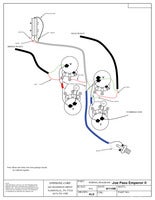paully
Rookie Solder Flinger

Posts: 2 
Likes: 0
|
Post by paully on Jul 5, 2015 7:25:47 GMT -5
 Did a lot of searching to find this. Hope it helps someone else. |
|
|
|
Post by rexyellowdog on Feb 27, 2016 8:47:36 GMT -5
paully,
where can I find that diagram ? My samick JP needs help. A bit difficult to see your posted pic.
Thank you, Bob
|
|
|
|
Post by reTrEaD on Feb 27, 2016 20:25:49 GMT -5
Hello Bob. Just click on the small image. A larger image will appear.
(You must be logged in to see the larger image.)
Cheers!
|
|
|
|
Post by sumgai on Feb 27, 2016 23:30:17 GMT -5
I'm not too sure how this PASSed by me the first time....
paully, there is a small problem with your diagram... it goes to some lengths to specifically illustrate the ground leads, but it leaves out one of them. In any hollow or semi-hollow body guitar, one should not infer that a common piece of foil (or copper, or paint, or whatever) will be installed such that it makes mechanical contact with all of the controls. Indeed, such guitars are seldom shielded in any meaningful way, that job is left to better quality coax-style wire between the components, and is also why you so rarely see single-coil pickups in there - humbuckers are there for a reason.
In the case of this Joe Pass unit, the ground for the two Bridge controls is not connected to the output jack, whereas the Neck's controls are so connected. This would have the result of no sound coming from the Bridge, or at best, a noisy and very weak tonal output. (Seeing as how the Bridge pup's negative lead is also not getting to the output jack's ground, I'd lay money on no signal from that side of things at all.)
In nearly all solidbody axe drawings, the ground is inferred because the pickguard is, 99.% of the time, shielded with at least something that makes mechanical (and therefore also electrical) contact with all of the controls. In our opinion, meaning the consensus of us Nutz, that shielding material should not carry the "ground" portion of the pickup signal, but you know how people love to take a shortcut now and then.... In your diagram, it is done right, an actual wire for every connection, except for the one I have now mentioned. With that wire in place (electrically it won't make a difference where the wire goes, so long as the Bridge controls get a ground), then it will all look good, and play good, too. 
On another note.... I hate to pee in your CheeriosTM, but this is a standard Les Paul diagram - or indeed, it's a standard Gibson diagram. And while they may have been the first to use this circuit (up for debate, but I'm willing to let it ride), it is now so common as to no longer be worthy of "high regard". Additionally, this is what we call the "modern" style of wiring, as versus the "vintage" style. For more info on that, refer to this thread: Modern vs 50s wiring
However, all of that said, Joe Pass was an extremely excellent player, and had to Mojo Tone to go with it! 
HTH
.... Well, what the hey, why not? Indeed!
sumgai
|
|